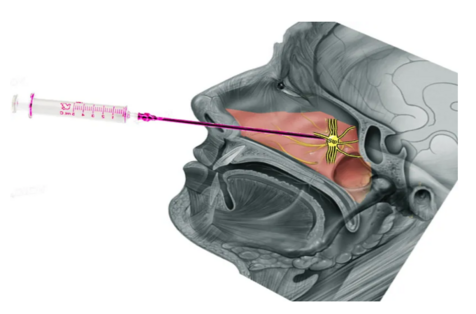Sphenopalatine block for migraine headache
Sphenopalatine ganglion block can be done up to 3 times weekly for up to 8 weeks. It is best done in presence of a headache to observe positive effect. Patients get almost immediate significant improvement of headache if it is going to work for them.
The general technique is applying topical anesthetic to the mucosa behind the middle nasal turbinate, which covers the parasympathetic sphenopalatine ganglion. It can be applied by dripping into the nostril while supine, applying directly with an applicator, or by spraying as described below in Dr. Calvin Vermeire's preferred technique:
Generally, 0.6-0.7 mL of bupivacaine is used with a 3 mL syringe and an 18 or a 20 catheter (Angiocath, Intercath) with needle removed but used to draw or you can discard needle or use regular needle to draw. Usually use 2 syringes and one catheter.
Advise patient of the horrible taste of the bupivacaine; give basin or tissue to spit if needed. Advise that the throat will be numb for up to 2 hours after. Be careful especially hot liquids/foods.
With patient seated and head straight; observe the nostrils to see where exactly the catheter will pass easily; one side is usually more open than the other, but even if it looks obstructed the catheter will usually pass without pain. The catheter should be angled about 30 degrees upward and, if possible, toward the lateral side of the back of the nose. You are going between the inferior and middle turbinate generally. If patient is tilting head backward as they usually try to do, adjust angle accordingly.
Insert the catheter past the turbinate about 2/3 the length of the catheter and spray the bupivacaine forcibly to the back of the nose; withdraw and reload for the other side. Patients usually take 30 to 60 seconds to recover from the taste. Rarely gagging occurs.
